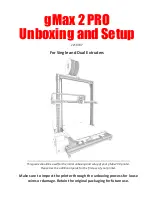
18
3D SYSTEMS, INC
.
CLUMPING
Description:
Agglomerated material on the material bed surface
accumulates in front of the roller as it moves across the print bed
and streaks appear behind the roller.
Theory of Cause:
This is usually the result of one of the following:
•
Improperly sifted, recycled material.
•
Overheating the material in the feed hopper
•
Debris pushed into overflow transport.
•
Contaminants in compressed air or air line.
Visual Signs:
The roller pushes clumps across the print bed which may cause streaks to appear after the roller passes.
Consequences:
Material does not feed properly, causing poor quality parts. Improper material feeding causes uneven material
thickness, which may cause growth or inadequate melting. Streaks may be apparent on upward and downward facing surfaces
of parts.
Corrective Action:
Reduce the temperature setpoints for the feed hopper.
Thoroughly sift recycled material before using it. See
Recycling Material
and
Sifting Material
.
Make sure your material storage methods do not allow contaminants into the material. The section “Material Storage and
Disposal” describes appropriate material storage.
Make sure the supply for clean dry air meets the specifications given in your printer’s Facility Guide.
If clumping occurs in an area of the print bed that does not contain the part(s), you probably can continue the print job.
If clumping occurs in the area of the print bed containing the part(s), you may not be able to complete the print job successfully.
If you terminate the print, do the following:
1. Discard any lumps of material.
2. Clean the print chamber.
3.
Clean the overflow screen.
4. Clean the roller.
Related Problems:
“Cracking of Print Bed”
Theory of Cause:
When the first layer is scanned, the laser penetrates to the unmelted material below the print boundary. In
extreme cases, bonus Z will occur with wash out.
Visual Signs:
You cannot observe this during printing.
Consequences
: The part is out of tolerance in the Z axis.
Corrective Action:
While printing, there are no corrective actions you can take.
Prior to beginning the print job, you can:
•
Minimize the possibility of bonus Z by reducing the Fill Laser Power parameter in the Print Profile for the first few layers
(between the first and fourth layers).
•
Use the Z-growth compensation features of Build Setup; see your Build Setup help.
If bonus Z occurs, you can clean the part during post-processing by sanding or machining off the appropriate amount.
Related Problems:
“Wash Out”
Side view of roller and
powder, showing clumps
CRACKING OF PRINT BED
Description:
The surface of the print bed cracks open as the roller moves
across it.
Theory of Cause:
Excessive heating rate or temperature from the heaters
causes partial melting of material on the print bed surface(s). Mechanical
problems with the roller can also cause cracking of the print bed. If you
suspect mechanical problems, contact 3D Systems.
Visual Signs:
Cracks appear on the surface of the bed.
Consequences:
If the part is printed in the area that is cracking, the part will crack too.
Corrective Action:
Decrease the Print Heater PID Setpoint in 2°C increments until the crack disappears.
If cracking occurs during the warm-up stage, you may have ramped up the temperature too quickly. Do not ramp to the final
set point until IR camera control of heater ratios starts, (approximately 6-7 mm into the warm-up stage).










































